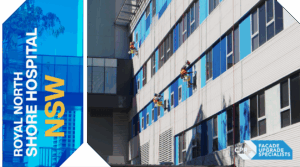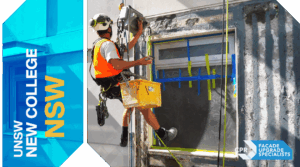The IRATA Standard: Why Your Remediation Contractor’s Rope Access Certification Matters is more than a technical checkbox – it is one of the strongest predictors of safety, quality, and long-term value in rope access remediation. For strata committees under pressure to make wise financial decisions, and for building managers and consultants who must guarantee professional execution, IRATA rope access certification offers the transparency, assurance, and risk reduction they need.
Choosing a contractor without certified rope access technicians may expose your building to unnecessary risk, hidden costs, and the possibility of re-doing works far sooner than expected. That is why the IRATA Standard has become the benchmark for compliant rope access practices and safer, higher-quality remediation on difficult-to-access building facades.
Why the IRATA Standard Matters for High-Rise Remediation
Whether you are responsible for a 1970s strata tower or a complex commercial façade, rope access remediation demands precision. IRATA certification ensures that every technician performing high-risk work at height has been trained, assessed, and audited under the world’s most recognised industrial rope access standards.
For strata committees, this translates into peace of mind – knowing the team outside your windows is not improvising but following a globally recognised safety framework. For building managers and consultants, it offers a defensible standard: a credential that reduces liability and proves the contractor is fully qualified for industrial maintenance rope access.
IRATA certification supports:
- Safer work methodology that reduces incidents on-site
- Higher quality outcomes through strict technician assessment
- Consistency, because IRATA rope access training requirements are international
- Reduced disruption, as IRATA teams work faster with minimal setup time
- Alignment with high-risk work safety certification obligations
And when combined with CPR’s Scaffold-Free™ systems – MARS™, PEARS®, and the SkyPod® workstation – IRATA certification becomes part of a fully integrated safety framework that transforms how façade remediation is delivered on tall, difficult-to-access buildings.
The Real Cost of Hiring Non-Certified Rope Access Contractors
It is natural for strata committees to feel anxious about cost blowouts, unclear scopes, and unexpected reworks. Many have lived through negative experiences: shortcuts in workmanship, unqualified workers at height, or scopes written by middlemen with conflicting interests.
Hiring a contractor without proper rope access certifications may appear more affordable upfront, but it often results in:
- Unquantified defects being missed during inspection
- Incorrect or inappropriate repair methods
- Unsafe manoeuvres performed at height
- Slower productivity and extended project timelines
- More resident complaints about noise, dust, and privacy
- A higher risk of patchwork repairs that fail early and must be re-done
IRATA certification is one of the most reliable safeguards against these issues. It protects the building, the people doing the work, and the decision-makers responsible for approving the project.
Breaking Down IRATA Certification Levels
IRATA Level 1 – Certified Rope Access Technician
The entry-level qualification confirms technicians can perform a wide range of industrial rope access tasks under supervision. They are competent in basic rigging, manoeuvring, and safety procedures.
IRATA Level 2 – Advanced Rope Access Technician
Level 2 technicians are responsible for more complex manoeuvres, hauling systems, and advanced rigging. They ensure compliant rope access practices on-site and support the supervisor in planning safe access strategies.
IRATA Level 3 – Rope Access Supervisor (the gold standard)
Every IRATA job must be overseen by a Level 3 supervisor. They are responsible for:
- Rescue procedures and emergency planning
- Safety compliance and daily checks
- Anchor inspections and approvals
- Technical oversight of the system design
- Risk assessments and method statements
This tiered structure ensures every high-risk action is covered by qualified professionals – not guesswork.
IRATA vs SPRAT: Why IRATA Leads in Remediation Work
Both IRATA and SPRAT are recognised frameworks for rope access. However, IRATA’s auditing, assessment, and certification processes are widely regarded as more rigorous for the type of rope access remediation typically required on large façades and complex remedial projects.
IRATA certification is especially preferred for:
- Concrete repair work at height
- Water ingress rectification in ageing façades
- Cladding rectification and high-risk remedial works
- Large strata buildings with complex access constraints
For strata committees who fear making a bad choice or being “sold” unnecessary work, choosing IRATA-certified teams is a practical way to eliminate a significant portion of risk and uncertainty.

Where IRATA Certification Meets CPR’s Scaffold-Free™ Technology
IRATA provides the human skill. CPR provides the technological advantage.
CPR is one of Australia’s only remediation specialists to combine IRATA-certified technicians with a fully engineered suite of Scaffold-Free™ systems designed specifically for difficult-to-access building facades:
- MARS™ – Multiple Access Rope System, which means for you… fully independent manoeuvrability around the façade, with rope drops aligned to a precise grid system and no need for internal apartment access.
- PEARS® – Portable Elevation Access Rope System, which means for you… faster lifting of materials and tools, reducing project timelines and delivering significant cost savings on labour and logistics.
- SkyPod® – Encapsulated building remedial workstation, which means for you… cleaner, safer repairs with no falling debris, reduced dust, quieter operations, and minimal impact on residents and businesses.
- SKY-FIMMS™ – CPR’s digital twin inspection and management platform, which means for you… a transparent, data-backed record of every defect, every patch, and every repair, all mapped and traceable over the life of the building.
These proprietary systems remove the need for scaffolding – often the single most expensive component of traditional façade remediation – delivering significant cost savings and dramatically shorter timelines while preserving privacy and reducing disruption.
How IRATA Certification Supports SKY-FIMMS™ Transparency
SKY-FIMMS™ provides every strata committee and building manager with the visual proof they have always wanted. But its accuracy depends on the person carrying out the inspection.
With IRATA-qualified technicians, CPR can perform:
- True close-up inspections of every metre of the façade
- Hands-on testing of concrete, cladding, coatings, and joints
- Volume quantification of each defect category
- Detailed defect mapping aligned to drops, levels, and patch numbers
- High-risk concrete and cladding assessments that stand up to external review
This aligns perfectly with CPR’s SFS360® and SE2EPC® quality assurance systems, ensuring every patch, drop, level, and photograph is backed by qualified rope access remediation specialists – not uncertified labour. Which means for you… a clear, defensible record of what was wrong, what was done, and how your funds were invested.
Why Strata Committees Should Prioritise IRATA Certification
Strata committees often tell us:
- “We just do not want to make an expensive mistake.”
- “We want a team we can trust for the long term.”
- “We cannot afford to fix this twice.”
- “Residents will complain if the work is noisy or intrusive.”
IRATA certification directly addresses these fears by ensuring:
- Lower risk – safer works at height on live, occupied buildings
- Better value – fewer delays, fewer reworks, and a higher standard of workmanship
- Higher quality – technicians follow strict industrial rope access standards
- Minimal disruption – rope access is fast, quiet, and unobtrusive compared with scaffolding
- Better transparency – when paired with SKY-FIMMS™, nothing is hidden or vague
When combined with CPR’s Scaffold-Free™ methodology and AssetCare™ long-term preservation planning, strata committees gain a multi-decade solution that protects their investment and reduces the likelihood of future special levies.
Why Building Managers and Consultants Prefer IRATA Teams
Building managers and consultants look at remediation through a technical and operational lens. Their concerns revolve around:
- Safety compliance and incident prevention
- Proper methodology and specification alignment
- Risk management and insurance
- Documentation and quality assurance
- Minimising complaints from residents and tenants
- Ensuring the job is done once, correctly, and traceably
IRATA rope access standards give them:
- Documented compliance with high-risk work safety certification and rope access safety standards
- A credible framework for rope access contractor qualifications
- Fewer WHS concerns and more robust rescue planning
- Faster workflows and clearer reporting from site to boardroom
When this is combined with CPR’s SKY-FIMMS™ digital records, managers gain defensible documentation for every stage of the project. Which means for you… fewer headaches, easier handovers, and confidence when questioned by owners, auditors, or regulators.
How to Choose a Rope Access Contractor You Can Trust
When evaluating a rope access remediation provider for a high-rise or difficult-access building, ask for:
- Proof of IRATA certification levels for each technician
- Confirmation that a Level 3 IRATA supervisor will be on-site for all rope access works
- Details of their rescue plan and high-risk work procedures
- Evidence of past rope access remediation, not just window cleaning or basic maintenance
- Examples of close-up defect photography and defect mapping
- References or video testimonials from strata buildings and commercial projects
- A clear explanation of their access system, including how they minimise disruption
- A transparent scope and cost structure backed by measured quantities from a structured inspection
A trustworthy rope access contractor will welcome these questions and will be able to demonstrate compliant rope access practices as part of a broader quality assurance framework.
Why CPR Sets a Higher Benchmark Than Typical Rope Access Providers
CPR is not a rope access company that happens to do remedial works.
CPR is a building remediation specialist that uses advanced rope access systems as part of a wider, engineered methodology.
Our teams are:
- IRATA-certified at all required levels
- Trained through CPR’s Elevation Training Academy
- Selected and monitored under the ASPs™ – Accredited Service Partners™ program
- Guided by SFS360® for precise façade scoping and SE2EPC® for end-to-end project care
- Equipped with Scaffold-Free™ technologies – MARS™, PEARS®, SkyPod® – for safe, efficient access
- Supported by SKY-FIMMS™ for full digital transparency
- Backed by AssetCare™ for long-term monitoring, maintenance, and preservation planning
This creates a level of accuracy, efficiency, and safety that typical rope access providers simply cannot match. Which means for you… a single, accountable partner for inspection, remediation, and long-term façade care.
Ready to Ensure Your Building Is Safe, Compliant, and Properly Cared For
See exactly what IRATA-certified technicians combined with CPR’s Scaffold-Free™ systems can do for your building.
You can book a professional façade inspection through our dedicated building facade inspection service, which means for you… a clear, data-backed roadmap for remediation instead of guesswork.
If you want to understand the access side in more depth, explore:
- MARS™ – Multiple Access Rope System
- PEARS® – Portable Elevation Access Rope System
- SkyPod® – Building Remedial & Maintenance Workstations
For a full view of CPR’s end-to-end remediation capability, visit CPR Facade Upgrades and discover how Scaffold-Free™, data-driven remediation can deliver safer, more affordable, and longer-lasting outcomes for your building.






